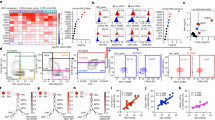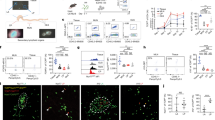Abstract
Functionally diverse T cell populations interact to maintain homeostasis of the immune system. We found that human and mouse antigen-activated T cells with high expression of the lymphocyte surface marker CD52 suppressed other T cells. CD52hiCD4+ T cells were distinct from CD4+CD25+Foxp3+ regulatory T cells. Their suppression was mediated by soluble CD52 released by phospholipase C. Soluble CD52 bound to the inhibitory receptor Siglec-10 and impaired phosphorylation of the T cell receptor–associated kinases Lck and Zap70 and T cell activation. Humans with type 1 diabetes had a lower frequency and diminished function of CD52hiCD4+ T cells responsive to the autoantigen GAD65. In diabetes-prone mice of the nonobese diabetic (NOD) strain, transfer of lymphocyte populations depleted of CD52hi cells resulted in a substantially accelerated onset of diabetes. Our studies identify a ligand-receptor mechanism of T cell regulation that may protect humans and mice from autoimmune disease.
This is a preview of subscription content, access via your institution
Access options
Subscribe to this journal
Receive 12 print issues and online access
$209.00 per year
only $17.42 per issue
Buy this article
- Purchase on Springer Link
- Instant access to full article PDF
Prices may be subject to local taxes which are calculated during checkout







Similar content being viewed by others
References
Hori, S., Nomura, T. & Sakaguchi, S. Control of regulatory T cell development by the transcription factor Foxp3. Science 299, 1057–1061 (2003).
Fontenot, J.D., Gavin, M.A. & Rudensky, A.Y. Foxp3 programs the development and function of CD4+CD25+ regulatory T cells. Nat. Immunol. 4, 330–336 (2003).
Shevach, E.M. From vanilla to 28 flavors: multiple varieties of T regulatory cells. Immunity 25, 195–201 (2006).
Corthay, A. How do regulatory T cells work? Scand. J. Immunol. 70, 326–336 (2009).
Long, S.A. & Buckner, J.H. CD4+FOXP3+ T regulatory cells in human autoimmunity: more than a numbers game. J. Immunol. 187, 2061–2066 (2011).
Gavin, M.A. et al. Single-cell analysis of normal and FOXP3-mutant human T cells: FOXP3 expression without regulatory T cell development. Proc. Natl. Acad. Sci. USA 103, 6659–6664 (2006).
Wang, J., Ioan-Facsinay, A., van der Voort, E.I., Huizinga, T.W. & Toes, R.E. Transient expression of FOXP3 in human activated nonregulatory CD4+ T cells. Eur. J. Immunol. 37, 129–138 (2007).
Roncarolo, M.G. & Gregori, S. Is FOXP3 a bona fide marker for human regulatory T cells? Eur. J. Immunol. 38, 925–927 (2008).
Miyara, M. et al. Functional delineation and differentiation dynamics of human CD4+ T cells expressing the FoxP3 transcription factor. Immunity 30, 899–911 (2009).
Liu, W. et al. CD127 expression inversely correlates with FoxP3 and suppressive function of human CD4+ T reg cells. J. Exp. Med. 203, 1701–1711 (2006).
Seddiki, N. et al. Expression of interleukin (IL)-2 and IL-7 receptors discriminates between human regulatory and activated T cells. J. Exp. Med. 203, 1693–1700 (2006).
von Herrath, M.G. & Harrison, L.C. Antigen-induced regulatory T cells in autoimmunity. Nat. Rev. Immunol. 3, 223–232 (2003).
Harrison, L.C. Vaccination against self to prevent autoimmune disease: the type 1 diabetes model. Immunol. Cell Biol. 86, 139–145 (2008).
Dromey, J.A. et al. Generation and expansion of regulatory human CD4+ T-cell clones specific for pancreatic islet autoantigens. J. Autoimmun. 36, 47–55 (2011).
Xia, M.Q., Tone, M., Packman, L., Hale, G. & Waldmann, H. Characterization of the CAMPATH-1 (CDw52) antigen: biochemical analysis and cDNA cloning reveal an unusually small peptide backbone. Eur. J. Immunol. 21, 1677–1684 (1991).
Hale, G. Cd52 (Campath1). J. Biol. Regul. Homeost. Agents 15, 386–391 (2001).
Baron, U. et al. DNA methylation in the human FOXP3 locus discriminates regulatory T cells from FOXP3+ conventional T cells. Eur. J. Immunol. 37, 2378–2389 (2007).
Tone, M. et al. Structure and chromosomal location of mouse and human CD52 genes. Biochim. Biophys. Acta 1446, 334–340 (1999).
Chen, G.Y., Tang, J., Zheng, P. & Liu, Y. CD24 and Siglec-10 selectively repress tissue damage-induced immune responses. Science 323, 1722–1725 (2009).
Adorini, L., Gregori, S. & Harrison, L.C. Understanding autoimmune diabetes: insights from mouse models. Trends Mol. Med. 8, 31–38 (2002).
Augstein, P. et al. Beta-cell apoptosis in an accelerated model of autoimmune diabetes. Mol. Med. 4, 495–501 (1998).
Shevach, E.M. Mechanisms of foxp3+ T regulatory cell-mediated suppression. Immunity 30, 636–645 (2009).
Sakaguchi, S., Wing, K., Onishi, Y., Prieto-Martin, P. & Yamaguchi, T. Regulatory T cells: how do they suppress immune responses? Int. Immunol. 21, 1105–1111 (2009).
Collison, L.W. et al. The inhibitory cytokine IL-35 contributes to regulatory T-cell function. Nature 450, 566–569 (2007).
Treumann, A., Lifely, M.R., Schneider, P. & Ferguson, M.A. Primary structure of CD52. J. Biol. Chem. 270, 6088–6099 (1995).
Mustelin, T. & Tasken, K. Positive and negative regulation of T-cell activation through kinases and phosphatases. Biochem. J. 371, 15–27 (2003).
Varki, A. & Angata, T. Siglecs–the major subfamily of I-type lectins. Glycobiology 16, 1–27 (2006).
Crocker, P.R., Paulson, J.C. & Varki, A. Siglecs and their roles in the immune system. Nat. Rev. Immunol. 7, 255–266 (2007).
Nguyen, D.H., Hutado-Ziola, N., Gagneux, P. & Varki, A. Loss of Siglec expression on T lymphocytes during human evolution. Proc. Natl. Acad. Sci. USA 103, 7765–7770 (2006).
MacDonald, H.R., Bron, C., Rousseaux, M., Horvath, C. & Cerottini, J.C. Production and characterization of monoclonal anti-Thy-1 antibodies that stimulate lymphokine production by cytolytic T cell clones. Eur. J. Immunol. 15, 495–501 (1985).
Korty, P.E., Brando, C. & Shevach, E.M. CD59 functions as a signal-transducing molecule for human T cell activation. J. Immunol. 146, 4092–4098 (1991).
Thompson, L.F., Ruedi, J.M., Glass, A., Low, M.G. & Lucas, A.H. Antibodies to 5′-nucleotidase (CD73), a glycosyl-phosphatidylinositol-anchored protein, cause human peripheral blood T cells to proliferate. J. Immunol. 143, 1815–1821 (1989).
Rowan, W.C., Hale, G., Tite, J.P. & Brett, S.J. Cross-linking of the CAMPATH-1 antigen (CD52) triggers activation of normal human T lymphocytes. Int. Immunol. 7, 69–77 (1995).
Watanabe, T. et al. CD52 is a novel costimulatory molecule for induction of CD4+ regulatory T cells. Clin. Immunol. 120, 247–259 (2006).
Kubota, H. et al. Identification and gene cloning of a new phosphatidylinositol-linked antigen expressed on mature lymphocytes. Down-regulation by lymphocyte activation. J. Immunol. 145, 3924–3931 (1990).
Haaland, R.E., Yu, W. & Rice, A.P. Identification of LKLF-regulated genes in quiescent CD4+ T lymphocytes. Mol. Immunol. 42, 627–641 (2005).
Varki, A. Natural ligands for CD33-related Siglecs? Glycobiology 19, 810–812 (2009).
Clatworthy, M.R., Wallin, E.F. & Jayne, D.R. Anti-glomerular basement membrane disease after alemtuzumab. N. Engl. J. Med. 359, 768–769 (2008).
Coles, A.J. et al. Pulsed monoclonal antibody treatment and autoimmune thyroid disease in multiple sclerosis. Lancet 354, 1691–1695 (1999).
Coles, A.J. et al. Alemtuzumab vs. interferon β-1a in early multiple sclerosis. N. Engl. J. Med. 359, 1786–1801 (2008).
Cossburn, M. et al. Autoimmune disease after alemtuzumab treatment for multiple sclerosis in a multicenter cohort. Neurology 77, 573–579 (2011).
Xia, M.-Q. et al. Structure of the CAMPATH-1 antigen, a glycosylphosphatidylinositol anchored glycoprotein which is an exceptionally good target for complement lysis. Biochem. J. 293, 633–640 (1993).
Belov, L., Huang, P., Barber, N., Mulligan, S.P. & Christopherson, R.I. Identification of repertoires of surface antigens on leukemias using an antibody microarray. Proteomics 3, 2147–2154 (2003).
Armour, K.L., van de Winkel, J.G., Williamson, L.M. & Clark, M.R. Differential binding to human FcγRIIa and FcγRIIb receptors by human IgG wildtype and mutant antibodies. Mol. Immunol. 40, 585–593 (2003).
Schmidt, T.G. & Skerra, A. The Strep-tag system for one-step purification and high-affinity detection or capturing of proteins. Nat. Protoc. 2, 1528–1535 (2007).
Herold, M.J., van den Brandt, J., Seibler, J. & Reichardt, H.M. Inducible and reversible gene silencing by stable integration of an shRNA-encoding lentivirus in transgenic rats. Proc. Natl. Acad. Sci. USA 105, 18507–18512 (2008).
Acknowledgements
We thank M.R. Clark (University of Cambridge) for DNA encoding immunoglobulin G1 Fc; and L. Belov, K. Ngui, A. Neale, J. Butler, D. Mittag, M. Herold, N. Stone, N. Lynch, H. Thomas, S. Finch and T. Adams for technical assistance and advice. Supported by the National Health and Medical Research Council of Australia (637301 to L.C.H. and 516700) and facilitated by the Victorian State Government Operational Infrastructure Support and Australian Government National Health and Medical Research Council Independent Research Institutes Infrastructure Support Scheme.
Author information
Authors and Affiliations
Contributions
L.C.H., J.A.D., E.B.-S., Y.Z., S.R., B.-H.L., J.Q. and R.M.B. designed the studies; L.C.H. drafted the manuscript; E.B.-S., Y.Z. and R.M.B. assisted in redrafting the manuscript; and all authors did the molecular and cellular studies, analyzed the data and discussed and commented on the manuscript.
Corresponding author
Ethics declarations
Competing interests
The authors declare no competing financial interests.
Supplementary information
Supplementary Text and Figures
Supplementary Figures 1–6 and Supplementary Tables 1–2 (PDF 316 kb)
Rights and permissions
About this article
Cite this article
Bandala-Sanchez, E., Zhang, Y., Reinwald, S. et al. T cell regulation mediated by interaction of soluble CD52 with the inhibitory receptor Siglec-10. Nat Immunol 14, 741–748 (2013). https://doi.org/10.1038/ni.2610
Received:
Accepted:
Published:
Issue Date:
DOI: https://doi.org/10.1038/ni.2610
This article is cited by
-
Smith-specific regulatory T cells halt the progression of lupus nephritis
Nature Communications (2024)
-
Identification of potential diagnostic biomarkers of atherosclerosis based on bioinformatics strategy
BMC Medical Genomics (2023)
-
The emerging scenario of immunotherapy for T-cell Acute Lymphoblastic Leukemia: advances, challenges and future perspectives
Experimental Hematology & Oncology (2023)
-
Emerging phagocytosis checkpoints in cancer immunotherapy
Signal Transduction and Targeted Therapy (2023)
-
The intriguing roles of Siglec family members in the tumor microenvironment
Biomarker Research (2022)



